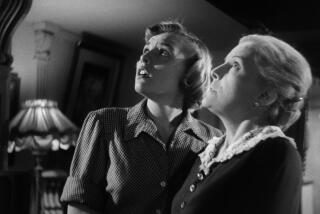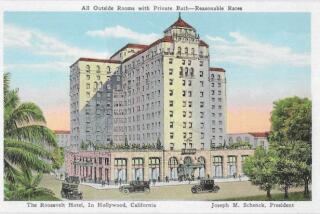Screening of Classic a Rare, Wonderful Event in Valley
- Share via
One of my favorite journalism gigs was in Buffalo, N.Y., where one of my many duties was to review any movies the principal movie critic didn’t want to bother with.
Since he was a man of enormous energy, that meant my reviewing was limited mostly to horror movies and classics being screened by the local university’s prestigious film program.
I hated doing the horror movies (you try watching “Night of the Living Dead” all alone in a cavernous theater at 10 in the morning). But writing about the old movies was a joy. I got to share my first reaction to ‘Camille,” for example, marveling as if it were 1936, instead of 1976, at the opulent use of black and white that was a hallmark of MGM in its heyday.
As a bonus, since I was, in effect, the old-movie critic, I got to interview the old movie-makers when they came to town.
Thus, I had dinner one night with Frank Capra, in Buffalo to talk about the propaganda films he made for the United States during World War II. He had wonderful insights about film as propaganda, not the least of which was that effective propaganda has more to do with effective filmmaking than with being on the side of the angels.
But best of all, he was Frank Capra. So when I asked how he felt when some critics dismissed him as a sentimentalist, he looked me in the eye and said, “Sentimental isn’t a four-letter word to me, ma’am.”
All this came to mind when I received a press release from the Alex Film Society about its offering Saturday night at the wonderfully restored Alex Theatre in Glendale, “Dinner at Eight.”
Videos are great, and I don’t know how we ever studied movies before we had them. But the fact is, movies were meant to be seen in movie theaters with other people--not sitting on your sofa, wearing your bunny slippers.
That’s true of all movies, not just new releases. The letter-box format is better than a cropped image, but it is no substitute for the in-theater movie experience. And, if you live in the Valley, your chances of seeing an old movie in an actual theater are virtually nil. Thank the movie gods for the Alex Film Society, which screens classic movies every few months the way they should be seen.
But why doesn’t the Valley have a full-time revival house to meet the needs of all of us who think access to old films is as vital as access to old books?
Even the Academy doesn’t screen movies in the Valley. If not in the Valley, where much of the industry is located, where? If Palo Alto and a zillion other small towns can have a revival house, why can’t we?
Which brings us to “Dinner at Eight.” Asked why the Alex Film Society chose to screen the 1933 George Cukor comedy, co-founder Brian Ellis says, “One, it’s a great picture.”
Greatness is just the first test of a film for the Alex, however. ‘It’s easy to find great titles,” he says. “It’s hard to get great prints.”
From MGM, the film stars Marie Dressler, John and Lionel Barrymore, Wallace Beery and Jean Harlow. Her blondness was dressed for the movie by the immortal Adrian. He designed a series of costumes for Harlow that are all silver or white, with the exception of a single black velvet hat. According to the film society newsletter, Harlow’s eye-popping evening gown was made without fasteners of any kind and was so tight she had to use a slant board to relax on since she couldn’t sit down in the dress.
“Dinner at Eight” was a hit Broadway play by Edna Ferber and George S. Kaufman before it was a film. Credit for the screenplay went to Frances Marion, Herman J. Mankiewicz and Donald Ogden Stewart.
Although only film buffs know her name today, Marion was the highest-paid screenwriter in Hollywood for 30 years, according to Cari Beauchamp, author of “Without Lying Down: Frances Marion and the Powerful Women of Early Hollywood” (Scribner, 1997). She was earning a record $3,000 a week in the 1920s. Beauchamp takes her title from Marion’s remark, “I spent my life searching for a man to look up to without lying down.”
Beautiful as well as talented, Marion was part of a circle of women who quietly but effectively supported each other, including Mary Pickford and Marie Dressler, both of whom gave Marion much of the credit for their success on screen.
Although none of the tension is reflected in the film itself, MGM was in turmoil when “Dinner at Eight” was made. Studio head Louis B. Mayer was furious at the popular view that he was a semiliterate yahoo and that the quality of MGM films was attributable to its ailing boy genius and head of production, Irving Thalberg.
According to Beauchamp, Marion was directed to write the screenplay for “Dinner at Eight” as part of Mayer’s attempt to shift power away from Thalberg by promoting David O. Selznick, the film’s young producer.
A dear friend of Thalberg’s, and later a dear friend of George Cukor’s, Marion may not have liked the assignment but she cranked out a draft in less than two weeks.
“Dinner at Eight” will be screened at 2 and 8 p.m. at the Alex, 216 N. Brand Blvd., (818) 754-8250. At the evening show, actress Karen Morley is expected to say a few words about the production.
“She’s the last surviving cast member,” Ellis explains. “I think she plays somebody’s wife.”
Now if we only had a revival house in the Valley, we might also get to see another great movie written by Frances Marion--’Camille.”
*
Spotlight runs every Friday. Patricia Ward Biederman can be reached at [email protected].
More to Read
Only good movies
Get the Indie Focus newsletter, Mark Olsen's weekly guide to the world of cinema.
You may occasionally receive promotional content from the Los Angeles Times.










